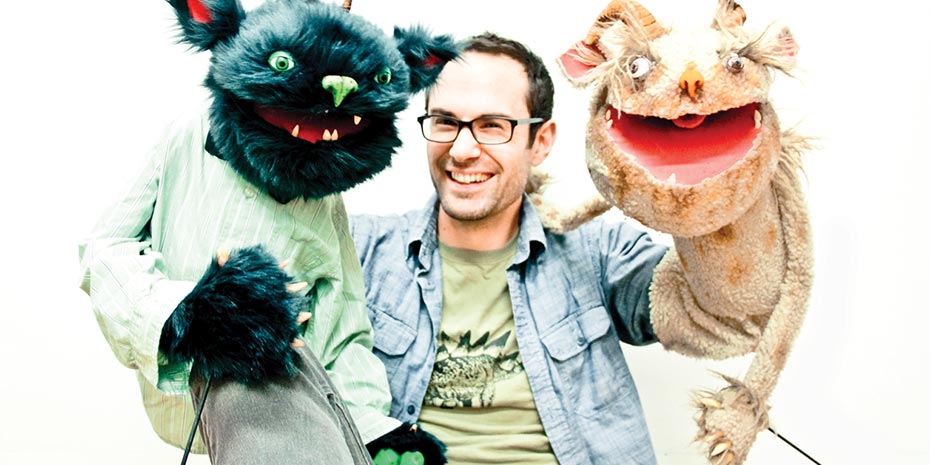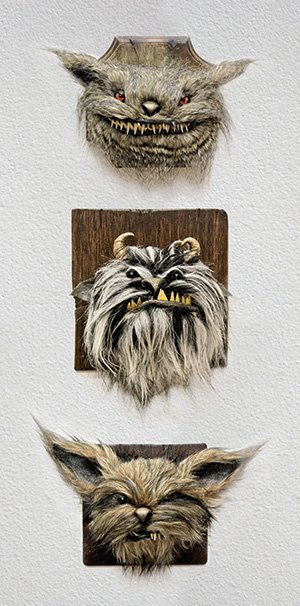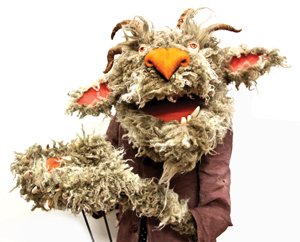Portland Artist Matthew Hopkins


Matthew Hopkins is one of those people who is just easy to like, and his puppets follow suit. Actually, after I spent a few moments around him, I was starting to ask myself: what’s not to like? Again, same for the puppets. ELEVEN was invited into his artist studio to discover a whole world created by Matthew. There was a John Lennon gargoyle in the room guarding over us, so I felt safe to ask anything that came to mind. To call Matthew a mere puppeteer would never do him justice. He is a man with the insight of a modern storyteller and the savvy of an authentically creative and intuitive individual.
ELEVEN: What is your medium? What materials are you using?
Matthew Hopkins: Foam, faux fur, faux leather, some repurposed leather. . . I try not to incorporate animal products, but sometimes I do. I started out doing puppets and it turned into these sort of taxidermy creatures, so it’s somewhere between sculpture and puppetry. I call my company Nightmerriment because the creatures are frighteningly cute. I got really frustrated after like a year of trying to think of a name. And then one afternoon as the sun was setting last september, it just snapped into my head and was all like “Knock knock knock I’m here!”
11: Where did you go to school?
MH: I went to Western Washington University and majored in theater and film.
11: What helped you make the transition between puppetry and taxidermy?
 MH: An art show. I was going to be part of an art show, and I was going to paint these pictures. It just wasn’t coming out right, and so I decided to take the idea of a puppet and stretch it over a board. So it was basically these monster puppets that I just stretched over squares. I don’t have any more of those unfortunately, because they all sold.
MH: An art show. I was going to be part of an art show, and I was going to paint these pictures. It just wasn’t coming out right, and so I decided to take the idea of a puppet and stretch it over a board. So it was basically these monster puppets that I just stretched over squares. I don’t have any more of those unfortunately, because they all sold.
11:What drew you to puppets and puppetry?
MH: I have always really liked puppets. I grew up with Jim Henson and The Muppets. But to me as a kid those were always characters. I mean, like Kermit was—well, that was Kermit. I think the first time I realized puppets were puppets was I was watching a video by Genesis called “Land of Confusion.” The characters are of the band and of Ronald Reagan and of pop culture icons of the ‘80s, and that was the first time that I saw that [and thought], “Oh, hey! Those are puppets.” I became fascinated with how they were made. That’s what kind of got me started liking puppets as an art form. I really got into puppet making in earnest with a company here in town called Action Adventure Theater. They were going to have these puppets made, and I said, “I can do that.” I made these alien puppets for a show called Captured By Aliens. That’s really how the ball started really rolling.
11:What is different about three-dimensional art versus two-dimensional art, like painting or drawing?
MH: It’s easier [laughing]. I find it easier, anyway. It’s easier for me to wrap my head around something in 3D rather than on a 2D surface.
11: Tell us where we can view your work! I think people really need to see this!
MH: I have pieces going up at Paxton Gate on June 12. It’s going to be up for I think a month. I also have work going up in The Maker’s Dozen show at the Peoples Art Gallery downtown. You can view some stuff online www.nightmerriment.com
11: How are monsters significant to you?
MH: You can kind of express different ideas and different emotions through the monsters. Especially within the puppetry, and in some of the puppet shows I’ve done with them. It makes it easier and more palatable for an audience to explore harder topics with something that’s not “real” (living, breathing). There is a puppet show that I am currently creating where all the monsters sort of live on the fringes of society. They take the sort of garbage of human culture and create their own culture. They’re very hidden from society—I mean from human society. During the course of the show, the monsters are faced with the conundrum of staying hidden, being persecuted, or coming out to live freely and like “normal” people. So themes of acceptance and accepting yourself. Sometimes monsters just don’t cooperate [laughing]. They really just will be and do what they want to do. Sometimes if I’m creating something, it just turns into its own thing. A fish will suddenly have wings and then it is a bird. Sometimes they are uncooperative, but at least they are always true to themselves. So the art shows contain characters that could potentially develop into a full-blown puppet show. Art shows for me are almost like a staging ground for what I might create and put into a puppet show.
11: Almost like a practice round for character development?
MH: Yeah, Exactly! I get to see what’s possible and what an audience responds to. People respond to different monsters for different reasons. A lot of people might connect to one or another because [they’ll think], “This looks like my dog,” or “This one just looks oh so cute and innocent.” Or, “I like this one because it has big teeth and it’s scary.” So yeah. . . it’s all different things and I think you get to see parts of different people’s personalities by seeing what they relate to.
11: Is there a puppet that stands out as a crowd pleaser?
MH: Agnar. He has sort of a Cheshire grin. He’s the first picture that you see on my website. There is something that people like about him a lot. That one, and the bird creature people really like a lot. My personal favorite is my puppet Greg. I can introduce you if you’d like to meet him. I have a hard time saying he’s my favorite because they are all kind of like my kids, you know, but really Greg is the favorite. He was in a benefit show until recently. He read some poetry with some of his friends.
11: Puppets reading poetry. This night just got so much better! If you could be doing anything with your puppetry, what would you be doing?
MH: If I could do anything with the puppets, I would love to have a television show. Like a puppet show. I might make a movie—I don’t know. I think it’s a great medium, and it reaches a lot of people. I mean, the puppets just want to be stars!
11: Do you have a favorite mythological creature or story of folklore?
MH: Ah yes, well I always really liked Bigfoot because it’s, you know, regional. I always really liked Baba Yaga too. That’s a Russian folktale about a witch that rides around in a house with chicken legs. It’s so weird and so good though. Mermaids are good too. I haven’t made any mermaid puppets yet, though.
11:Because they all grow wings and turn into birds, right?
MH: Haha yeah, that’s right! Oh, I forgot about the Brownies. Are you familiar with those creatures?
11: Nope, what are those?
MH: They are a little house-type creature that if you’re kind to them and leave them goodies, they will clean your house for you. If you’re rude to them, they will do terrible things like eat your cat and steal your things. I believe they are Scottish or Norse. Sometimes there is a carry-over with folklore in that area.
 11: What’s your experience being an artist in Portland?
11: What’s your experience being an artist in Portland?
MH: It’s an amazingly accepting and responsive community. Everybody is so nice and warm and welcoming and kind. I lived in Seattle for many years before I moved here about 8½ years ago. It was fine, but it wasn’t nearly as kind as Portland is. Also, there are a lot of truly amazing artists here.
11: Shout out time, Matthew! Anybody who deserves special recognition?
MH: Tim Oakley is the name that comes to mind. He is one of the reasons that I’m doing what I do now. He’s been so supportive and so generous letting me come in and work on his different projects. He works in film and television, and I got to do a lot of great things because of him. I also want to give a shout out to the universe—or the muse, or whatever it is, because it really helps me so much when I put out what I want and it mysteriously comes back to me. I feel weird taking credit for all of my ideas, because they truly are coming from somewhere unknown. »
– Veronica Greene




